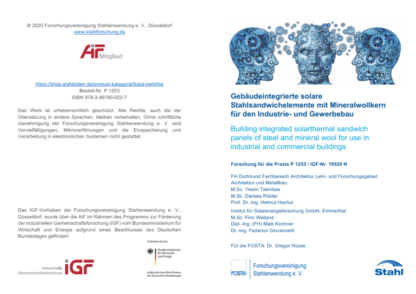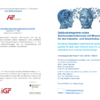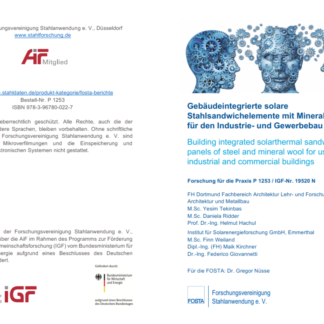Description
P 1253 – Building integrated solarthermal sandwich panels of steel and mineral wool for use in industrial and commercial buildings
Steel sandwich elements are well-established components in industrial and commercial construction. In addition to their outstanding cost-effectiveness, they are characterized by excellent physical properties. Future energy saving regulations will impose increasing demands on these wall and roof components. The current strategy to achieve this goal by increasing the component thickness is a passive measure and can be viewed critically in terms of resource and energy consumption. Therefore, the active solar-thermal upgrading of steel sandwich elements will be investigated in the project as an alternative solution. The solar radiation incident on the lightweight steel façade is absorbed by the cover shell, converted into heat and then transported by a liquid which flows through the pipe registers applied on the back of the panels. In order to maintain the architectural design, the components will be invisibly integrated into the structure of the sandwich module. Thus, active and inactive modules will be visually indistinguishable.
Preliminary positive results regarding elements with polyurethane foam core were already achieved in the FOSTA project P880, where the simpler feasibility was demonstrated in the context of elements with mineral wool core. Based on technologies from heating and cooling ceilings, different possibilities for solar thermal activation will be presented. Especially noteworthy is the further development of heat transfer plates made of ultra-fine steel sheets, which represent an important alternative to existing products in terms of statics, construction and building physics. In addition, it will be shown that economical solutions can be achieved with both copper and steel-based systems.
During the evaluation, structural, energetic and economic aspects are considered and the investigations are carried out on the simulative as well as on the experimental level. Among the aspects to be proven is the static improvement of the new element by means of solar thermal technology. The thermal efficiency is successfully tested on large-format demonstrators. Meanwhile, the analysis of commercially available coatings shows that the use of modules with different colors is possible. This guarantees a high degree of design freedom. In addition, specific solutions are developed for the industrial production of the solar-active sandwich elements. The aforementioned results are incorporated into typical application scenarios, taking into account both the direct use and the storage of heat energy using a variety of technological scenarios. The focus here lies on heat pump-based, low-temperature heat supply systems. For this purpose, typical demand profiles for industrial and commercial buildings are included and dynamic building simulations are carried out using an exemplary building and measured parameters of the panels. Main result of the research is the extension of the building system with sandwich elements. This will provide a possible direct approach to energy and resource savings.
Published in:
2020
Authors:
M.Sc. Y. Tekinbas, M.Sc. D. Ridder, Prof. Dr.-Ing. H. Hachul, Dipl.-Ing. (FH) M. Kirchner, Dr.-Ing. F. Giovannetti




